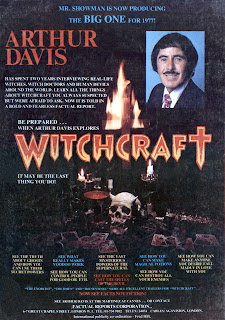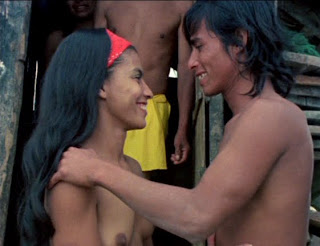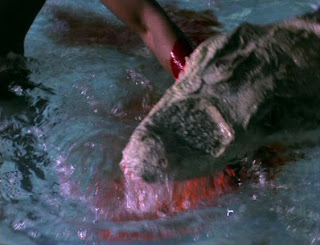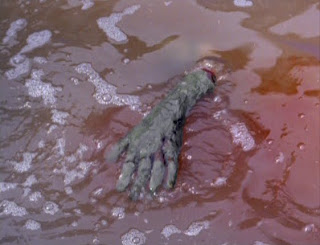Reviewed by Chris Poggiali
Arthur Davis, known as “Mr. International Showman” in the film distribution world, was a familiar face to people who read Variety during the 1960s and ‘70s. The son of a Florida movie theater owner, Davis followed in his father’s footsteps as an exhibitor before landing a job as a publicist for the film import company Mayer-Burstyn. He ran his own film import business in the States for several years before relocating to Tokyo in the early 1960s and establishing The Arthur Davis Company, a distribution outfit that provided Japanese TV stations and movie theaters with Italian and French movies. After more than a decade in Japan, Davis expanded his operation to Hong Kong and formed The Arthur Davis Organization -- “The leading independent showmanship group in Japan, Hong Kong and all the Far East,” according to the ads that frequently appeared in Variety (accompanied by a photo of Davis, always smiling). He also widened his scope to include the handling of German, British, and some American films, and by the mid-1970s his company was distributing over 22 titles a year throughout Asia. Logically, the next step for Davis would be the production of his own films.
It took an action-packed vacation in South America to convince Davis that truth was indeed stranger than fiction, at least in certain corners of the globe, and that a sensationalistic travelogue in the tradition of the enormously successful Italian “shockumentary” MONDO CANE (1962) -- and all its “Mondo” imitators -- would be a good way to ease into film production. The lifestyles and rituals of so-called primitive cultures in South America and Africa, committed to film, would hopefully provide enough shock value to get the movie sold in every conceivable film market in the world. Davis formed a new company called Factual Reports, opened a production office in London, and immediately put up $750,000 of his own money to start the motion picture that would become BRUTES AND SAVAGES. "Such films are relatively easy to make,” he boasted to Variety. “They have no cast and don’t need a name director to sell them” (Variety, May 11th, 1977, p. 6). Meanwhile, a second “factual report” -- a documentary about Japanese martial arts called THE ART OF KILLING -- would be shooting at the same time in Japan, with producer Hisao Masuda and director Masayoshi Nemoto in charge.
“All scenes whether actual or simulated represent actual truth.”
If we are to believe what is written in the Valkyrie Press paperback of BRUTES AND SAVAGES -- published in 1978 and credited to Davis and author Ben Parker -- Mr. International Showman and his crack team of documentary filmmakers (cameraman Jaime Questa, a soundman named Cedric, and their assistants, Hernando and Oliver) landed in Khartoum on July 4th, 1976 and journeyed to the southernmost part of the Sudan to film the “manhood ritual” of the Juba tribe. In other words, they were supposedly just three miles from the Ugandan border a day or two after Israeli commandos rescued 100 hostages from pro-Palestinian hijackers at Entebbe Airport. Never mind that the crocodiles devouring that Juba tribesman during the manhood ritual appear to be made of rubber in every third shot, or that the river they’re flailing around in looks like a swimming pool in every fourth shot, or that the Sudan itself bears a striking resemblance to Florida. Despite claims that BRUTES AND SAVAGES will show “1,001 forbidden scenes never before filmed,” viewers are still denied the sight of Arthur Davis’ head in Idi Amin’s refrigerator.
Next, our intrepid travelers hauled their equipment to South America -- Bolivia and Peru, to be exact -- where they captured on celluloid everything from fornicating llamas to x-rated Inca pottery. During the opening credits, we see footage of Uru tribesmen killing monkeys with blow darts and cooking them over an open fire. What we don’t see is footage of Davis and his crew vomiting into the river after learning that the meat they’ve just consumed is barbecued monkey, or shots of the Uru watching all of this from a distance, pointing and laughing hysterically.
All this and much more can be learned from the handsomely produced and entertainingly written mass market paperback from Valkyrie, which is approximately 225 pages in length and contains over 50 b&w photos interspersed throughout the text. (The copy in the Temple of Schlock library is signed by Davis with the inscription "To Cathy and Brad, two wonderful 'kids' that I wish were mine.") Other memorable passages that appear in the paperback but not the various versions of the film include:
– Davis grabbing a camera and scrambling out of his Land Rover to film snakes copulating by the side of the road
– Jaime hanging out of a tree with a “hidden camera,” filming the sacred Turtle Wedding ceremony of the Uru tribe. Please note that there’s nary a leaf in sight, let alone a whole tree, during the entire sequence (which was seemingly shot from about 10 different angles, all medium shots or close-ups, none above shoulder height)
– All references to Jimatl, the Inca Empire’s version of Hugh Hefner
– The legend of Ixlanta and Omonga, which explains the origin of cocaine
– A masturbating monkey in a tree strafing Cedric’s head with semen
– Said monkey getting blasted out of the tree five seconds later
– Davis being accosted by cocaine distributors interested in hiring him to smuggle a package back to Miami for $15,000
– Almost all references to Viracocha, the lord of all things, father of men, creator of lightning, rain, and the sun, and the reason the people living around Lake Titicaca chop a llama to pieces every once in a while
– All references to Llampa, which happens to be llama lubricant (I swear I’m not making this up)
– All references to chica, a highly potent whiskey distilled from berries and the leaves of coca plants
– All references to Manuel, one of Davis’ tour guides, who drank too much chica on the night of the llama mating ritual, insulted Viracocha, and promptly perished with a knife in his chest
– Davis stalking the elderly night watchman from the Museo Rafael Larco Herrera (“The Erotic Inca Museum”) and bribing him with 1 thousand pesos in order to obtain footage of the erotically illustrated soup bowls and drinking glasses in the museum’s collection
“Anyone who visits these places with a movie camera is automatically under suspicion,” Davis explained to Variety. “They figure an American has to be with the CIA and suddenly everything becomes difficult to organize” (Variety, May 11th, 1977, p. 6). In fact, Davis shot so much of his footage without legal consent that when it came time for him to leave South America, it was impossible for him to get all of the film stock past customs at once. He had to make several return trips to Bolivia and Peru and smuggle the footage out while posing as a tourist.
Back in London, Richard Johnson -- a British stage and screen actor blessed with a strong, distinctive voice -- was brought in to read the narration and possibly lend a touch of class to the sensationalistic proceedings. Distinguished enough to be considered for the role of James Bond when DR. NO (1962) was being cast, Johnson had portrayed British secret agent Bulldog Drummond in two very Bond-like espionage adventures, DEADLIER THAN THE MALE (1966) and SOME GIRLS DO (1969), and was a powerful presence in films such as NEVER SO FEW (1959), THE HAUNTING (1963), KHARTOUM (1966), and THE AMOROUS ADVENTURES OF MOLL FLANDERS (1966), in which he co-starred with Kim Novak, his wife for a short time. Although he had just handled narration duty on Moustapha Akkad’s critically acclaimed THE MESSAGE, a.k.a. MOHAMMED, MESSENGER OF GOD (1976), Johnson was in the middle of a career slump that usually landed him in Italian horror movies like BEYOND THE DOOR (1974), THE NIGHT CHILD (1975), ZOMBIE (1979), ISLAND OF THE FISHMEN (1979), and THE GREAT ALLIGATOR (1979). Although he's credited on the back cover of the novelization, his name appears nowhere in the credits of BRUTES AND SAVAGES.
For an original soundtrack score, Davis turned to Riz Ortolani, the Italian composer who not only scored the granddaddy of all shockumentaries, MONDO CANE, but also earned an Oscar nomination for that film’s theme song, “More.” With titles like ECCO (1963), WOMEN OF THE WORLD (1963), AFRICA ADDIO (1966), and FAREWELL UNCLE TOM (1971) on his résumé, Ortolani is the composer most closely identified with the Mondo genre. Most viewers will agree that he gave BRUTES AND SAVAGES the soundtrack it deserved -- a schlocky stew of world-jazz-funk-rock that’s as hopelessly dated as the film itself.
Fans of gimmicky technological advances in B-movies will be happy to know that BRUTES AND SAVAGES is recorded “In fantastic Brute Sound!!” A short article published in Variety during the film’s post-production (“Devise Brutesound for Arthur Davis’ ‘Savages’”) explains that the system, developed by a British engineer, “works on a single track and can be played through existing playback systems. Effect of Brutesound is to vary the intensity of a soundtrack. Seemingly, it can jack up the decibels by some 400% if necessary, or cut back the sound to a whisper” (Variety, August 17th, 1977 p. 31). Ironically, another article on the same page of the very same issue (“Hostile Climate in Britain for Filming, Prod. Davis Claims”) reveals that British lab technicians refused to work on the movie because they felt the soundtrack exploited cruelty to animals, and that Davis had to threaten to close the London office of Factual Reports and move his operation elsewhere in order to get a finished sound mix!
An additional headache for Davis was WITCHCRAFT, his third Factual Report, which was set to roll in September of 1977. Based on the files of UCLA professor Michael Donaldson and focusing on Japanese ghosts, Malaysian voodoo and other psychic phenomena, Davis had pre-sold the documentary to a dozen distributors on the strength of his claims that it would contain footage of an actual exorcism. That summer, after seeing Exorcist II: The Heretic bomb with both critics and ticket buyers, the distributors got nervous and asked to be released from the deal. WITCHCRAFT was scrapped, at a cost of nearly $100,000 of Davis’ own money.
Despite these setbacks, BRUTES AND SAVAGES was completed by autumn of 1977 and unveiled at MIFED that October, where Davis offered 104-minute and 94-minute versions for worldwide distribution. A year later, the 94-minute cut had its U.S. premiere at the Miami International Film Festival, where a Variety critic who attended the screening had generally positive things to say about it. “There will be censor opposition here and there, but for its designated types of audiences this one should do well. Photography is generally good, the scenery beautiful, the jungle scenes reek of the hazards of survival” (Variety, November 22nd, 1978). That same year, Davis sold the Arthur Davis Organization to his Japanese employees, who split up into 3 separate companies (Medallion Enterprises, Nan Enterprises, The Dela Corporation) in 1980. Davis returned to Florida and began a new career in real estate.
BRUTES AND SAVAGES remained unreleased in the United States until 1982, when Manhattan-based distributor Terry Levene acquired the film and gave it limited exposure through his company, Aquarius Releasing. A one-time sub-distributor of DEEP THROAT (1972), Levene -- like Davis -- specialized in the buying and selling of foreign films. Levene’s product was from Europe and Asia, and consisted mainly of kung fu, action and exploitation movies he would dub into English, re-edit, and then distribute to drive-ins and inner-city theaters in the U.S. with new titles and sleazy ad campaigns. From his office in the Selwyn Theater Building, in the heart of 42nd Street, Levene unleashed such tasty grindhouse treats as WOMEN IN CELL BLOCK 7 (1974), MEAN FRANK AND CRAZY TONY (1975), THE BLACK DRAGON VS. THE YELLOW TIGER (1975), KUNG FU MASSACRE (1975), and BRUCE LEE FIGHTS BACK FROM THE GRAVE (1978). In 1981, Aquarius ventured into more shocking territory when they handled two ultra-violent mondo documentaries, the American production FACES OF DEATH and the Italian-lensed SAVAGE MAN, SAVAGE BEAST.
The next year, Aquarius opened BRUTES AND SAVAGES at the 42nd Street Liberty Theater on Christmas Eve (!) for a one-week run, on a triple bill with their two previous mondo hits. With no advertising in any of the New York area newspapers, the film slipped in and out of town virtually unnoticed. The only critic who bothered to review it was Bill Landis, editor of the trend-setting fanzine Sleazoid Express, who wrote: “It’s a mostly dull Mondo movie containing often faked footage and an effeminate British explorer with a Prince Valiant haircut, whose travels through remote parts of South America provide the focal point. There’s too few laughs, but one neat scene of actual brain surgery, accompanied by Muzak on the soundtrack” (Sleazoid Express, vol. 3, no. 1, February 1983).
[The second Factual Reports production, THE ART OF KILLING, also made its belated theatrical debut in 1982. Under the title BUDO, it was released briefly through Crown International Pictures.]
The home video boom was soon in full swing, and product was needed to fill rental store shelves. MPI Home Video released a 92-minute cut of BRUTES AND SAVAGES -- presumably from the Aquarius theatrical print, since FACES OF DEATH was also a popular MPI title -- and it’s this version that circulated in the U.S. for nearly 20 years. In the second issue of his great, long-running fanzine Ecco, Charles Kilgore erroneously described Davis the Floridian as “an Italianate Emo Phillips lookalike” and the film itself as “a 1983 Italian pseudo-documentary,” but the crux of his review was right on the money: “From its opening credits set to a fourth-rate imitation Philly disco track to its final segment on a llama mating ritual, BRUTES AND SAVAGES squeezes all of the worst mondo elements together into one stinking cinematic turd. A segment on human cranial surgery provides the only evidence that a brain was involved in this entire sorry enterprise” (Ecco, vol. 1, no. 2, March/April 1988).
The differences between this truncated version of Davis’ “factual report” and the fully restored 107-minute “uncivilized” version released on DVD by Synapse Films in 2003 are evident from the first frame. The longer cut begins with Johnson reading the narration over 46 seconds of black screen (“We invite you to join the Arthur Davis Expedition to some of the untamed corners of the world…”), while the 92-minute version fills this darkness with a montage of animal footage and maps of South America. After the opening credits, the “uncivilized” version rolls out 28 minutes of footage supposedly shot in Africa. This entire sequence is cut from the beginning of the 92-minute version, which starts instead with Davis & company landing in South America. The llama sacrifice that originally followed the Turtle Wedding is moved forward so it comes before the visit to Death Village. Also, during the Turtle Wedding sequence, when the young couple consummates their marriage in a hammock, Johnson comments, “Love in a hammock is, well, something of a feat!” -- a quip that is in the 92-minute version but not the 107-minute version.
But the whopper comes 43 minutes into the shorter version: In between the montage of animals devouring each other and the trip to the coca groves, a 10-minute chunk of African footage (including the Juba tribesman being eaten by the crocodile) suddenly rears its head, with Davis’ nasally voice rudely cutting in on Johnson’s narration to explain, “In the interior of Brazil live a tribe originally survivors of a shipwrecked slave ship. These isolated people are dangerous!”
Obnoxious? Of course! Offensive? No doubt! Exploitative? You bet! Irresponsible? Welllll, let’s not go that far. After all, the promo art shows a man being eaten by a crocodile, so the Juba footage had to make the final cut somehow.
Besides, I’m still not entirely convinced that Davis ever set foot in Africa to begin with. Call me a skeptic, but I keep getting this mental image of him in front of a horse-drawn wagon with a bottle in his hand, trying to sell some amaaaaazing hair growth tonic or bunion oil to the same townspeople he fleeced one year earlier.
The Valkyrie paperback is probably the easiest and most entertaining way of digesting Davis’ nonsense, but those of you looking for the ultimate BRUTES AND SAVAGES cinematic experience are encouraged to seek out the “Uncivilized Version” on DVD from Synapse Films. It still doesn’t follow through on the promise of “1,001 forbidden scenes never before filmed,” but at least it replaces 18 minutes of rare Juba tribal footage -- and returns the Juba themselves to their rightful continent in the process. Oh, and just like the book, it is endorsed by the Institute of Primitive Arts and Cultures!























This is incredible. I can't believe you found all of this information on Davis, who I really thought was an imaginary "explorer". I wish you would publish the book here, I'd love to read it...
ReplyDelete